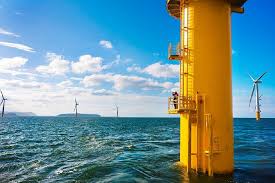Win Power
Win Power

Light weight design of wind turbine structures
The design of foundation structures for offshore wind turbines is governed by fatigue. To achieve a cost effective design, it is necessary to select a tower diameter that is large enough to reach the desired natural frequency, but preferably small enough to be less expensive. However, a light design tower will be fatigue sensitive reducing its expected service life. In order to increase the fatigue resistance of welds in a lighter design, the ultrasonic peening treatment can be applied. This can either extend the fatigue life in a traditional structure design or help to reduce the wall thickness in a lightweight reducing the amount of steel and weld metal required.
As a guideline the potential reduction of wall thickness could be as much as 30% decrease which could be achieved if fatigue is the only design limitation. However, buckling and tower driving influences the minimum required wall thickness. Therefore a reduction of 10% in the wall thickness could be a reasonably approach which consequently will entail a considerable reduction in steel weight of the structure.
For an offshore wind farm of 100 turbines, where each tower weights 167 tons, a total reduction of 10% on the steel tower would result in a reduction of 1670 tons. With constantly increasing steel prices any material saving would be very much welcomed. Furthermore, a reduced wall thickness will imply reduced weld metal and welding costs. This could be a significant step in making offshore wind energy more cost effective and environmental friendly.
Cost Reductions
Besides cost reductions related to material and production it will be further cost reductions in transportation and handling of the structure until it reaches its final location. Furthermore and considering the upcoming expansion on the Floating Offshore Wind Turbines sector, structural weight savings and/or increased fatigue endurance becomes factors of paramount importance.
